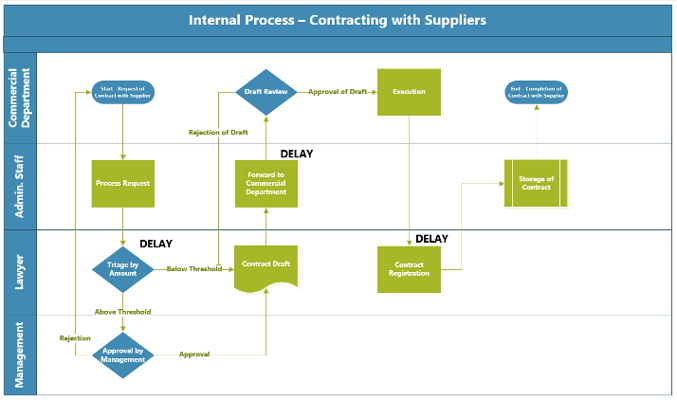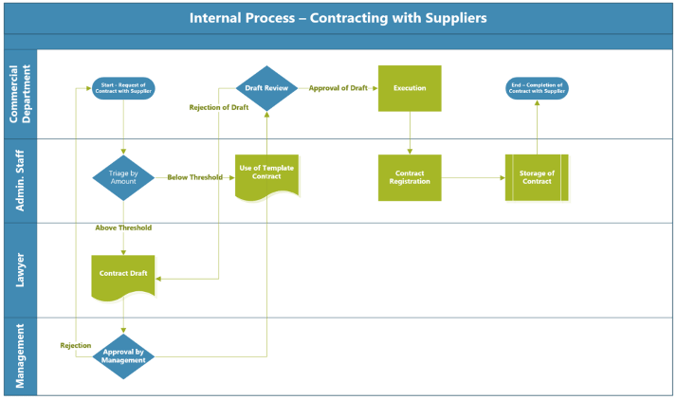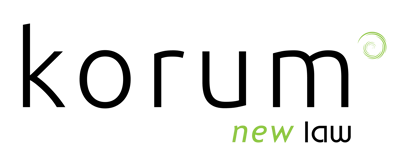What is Legal Process Mapping and How Legal Function Can Benefit from It.
.png)
What is Process Mapping?
Process Mapping is an operations management tool used to create a graphic representation of how things get done in a certain situation. It helps interested parties to visualise the details of a process and to determine the “Who”, “What”, “Where”, “Why”, “When” and “How” aspects of the process. The main objectives of process mapping are to bring transparency over the process, to identify its strengths and weaknesses, and to point to potential improvements. And, legal process mapping refers to the practice of visually documenting and analysing the steps, activities, and workflows involved in a specific legal process or procedure.
Benefits of Legal Process Mapping
1. Improved Understanding
Process mapping provides a clear and visual representation of the steps and activities involved in a process. This improves understanding among stakeholders, ensuring everyone has a shared understanding of how the process works.
2. Enhanced Communication
Process mapping facilitates effective communication and collaboration among stakeholders. It provides a common language and visual reference point, making it easier to discuss and align on process-related issues, improvements, and changes.
3. Standardisation and Consistency
Process mapping enables organisations to establish standardised procedures and best practices. It promotes consistency in how work is performed, leading to improved quality, efficiency, and customer satisfaction.
Process Mapping within the Legal Departments
Even though process mapping is seldom used in legal departments, Legal Process Mapping is a simple and useful tool to bring transparency to legal operations, and to guide decision making when determining future changes. Why? Because it allows anyone not familiar with the legal process – or even familiar with it - to get a simple grasp of the whole legal process at a glance. A process map can help assess the current situation and help to define and design future expectations.
A simple example of the usefulness of legal process mapping can be seen in a case in the following business case:
We need more lawyers!
KorumLegal was approached by a large multinational company (“MNC”) customer, who was planning to increase its headcount due to an increase of workload in the legal department mainly supporting contracting with suppliers. In order to support these changes, this MNC requested a Health Check and Process Optimisation – an accelerated audit of the existing legal processes and structures to confirm the challenges and determine possible courses of action.
The “Health Check” was a diagnostic of existing policies, procedures, and workflows to understand current modus operandi. It included 8 interviews with key internal stakeholders and then produced a legal process map of the internal contracting with suppliers. The whole legal process is reflected in the chart, with its 4 different actors, 11 steps and 3 decision trees. More importantly, the process map also revealed that contracting was facing delays, not only in the triage of the contracts, but also in the routing inside the company and in the contract administration and showed that the bottlenecks also involved the administrative team.

Fig. 1 - Process Mapping of the Contracting with Suppliers before the Audit
Do we need more lawyers?
After a careful analysis and interviews with key stakeholders, Korum completed the “Health Check and Optimisation” and suggested several recommendations. The legal process audit revealed that most problems existed in the triage, routing and administration of contracts, tasks which could be done differently in order to reduce the burden on lawyers. So what the customer thought was a headcount and resource issue, turned out to be something different.
Recommendations were specifically created to address these problems:
- The triage of contracts should be handled by administrative staff instead of lawyers – the triage of contracts is not a complex task (as long as the triage criteria is previously defined) and may be done by the administrative staff.
- Lawyers will only be involved in certain contracts – most transactions with suppliers were for small amounts and therefore was limited no need to involve the legal department. The commercial department may use contract templates previously created.
- The administration of contracts could be allocated to the administrative team.
These recommendations were discussed with the management and the stakeholders, and the MNC decided to adopt most of them. The recommendations enabled lawyers to focus on higher value tasks, and increased the efficiency of the whole department and the company, as a whole.

Fig. 2 – Process Mapping of Contracting with Suppliers after the adoption of recommendations
The Value of Legal Process Mapping
Legal Process Mapping is a powerful tool to illustrate complex process flows with multiple phases, tasks and stakeholders. This technique is extremely useful for legal departments who are looking to optimise their legal operations and to increase efficiencies, since it allows for the identification of unexpected complexity, problem areas, redundancies and potential areas of improvement. Legal Process mapping is also simple and cost effective and any company trying to optimise its legal operations should first create process maps of its legal operations in order to reveal existing problems and identify potential solutions, before resorting to other management or technology tools.
To find out more about how you can get started, get in touch us at: https://www.korumlegal.com/contact-us.
Joao Costa
Feb 28, 2023
Related Posts.
By: Huong Tang
Explore the Benefits of NewLaw: A New Era for Legal Industry
Rethinking Legal Spending in the Market
In the post-GFC world, whether you’re a large company, an SME or a start-up, you’re probably looking to do things leanly, especially with business functions..
By: Natasha Norton
I was recently asked to write this piece on the nature and value of dynamic teams and when I sat down to write it, a number of words and phrases started to leap out of my mud-mapping brain;
